What kayak or ocean ski racing rules would you change?

Recently reading a few of our blogs on the Sella Descent and paddling inventions, a paddling friend phoned to have a chat about weight of kayaks, gear and improving performance. The Sella with the cross over between river and marathon rules has all sorts of "innovations" such as electric pumps and ultralight weight kayaks. Some are even made so light they are only used to be raced once and not stay together for many more paddles.
This discussion with my friend then went in two directions exploring these two questions:
- “If you could change/add/remove one single rule in paddle racing, what would it be?”
- “How would you mechanically dope (cheat) in paddling?”
Please keep in mind, this is just a recap of a conversation between two paddlers having some fun musing rather than inciting people to cheat or revolt against the ICF’s rules.
We encourage you to post your ideas, call out your friends who might mechanically dope and share any innovations that may be dubious in the eyes of the ICF judges. Let us know in the comments section below what your No.1 rule change is and how you would (or are currently) mechanically doping in paddling? (it is anonymous 😉).
Rule changes in paddle racing
The rule change exposed our lack of knowledge of the intricate detail of the International Canoe Federation rules. The recent admission to allow weed deflectors into both sprint and marathon racing being one new that both of us didn't know about. With the exclusion of anti-doping rules, our conversation looked at ocean ski racing, marathon and sprint kayaking.

Ocean ski racing was quite difficult to fault with so few restrictions on the surfskis themselves and racing formats more determined by the conditions and environment than rules. The format of beach finishes was raised as an opportunity. This is where you paddle through the surf onto the beach, leave your surfski on the shore and sprint up the beach to run through the finishing flags. Our conversation was reminiscent of the pitch for change in The Paddler’s Pod (in episode 18). After all we are paddlers, not runners, so an on-water paddle through the finish may be something to look into, especially those who suffer from numb legs.
Marathon paddling led our conversation to visions of the Tour de France on water with 4 or more paddlers as the team size. This would increase from the 2 per nation per event enabling World Cup and World Championships to have more road cycling tactics utilised. Diamonds of each nations paddlers hunting wins in the discipline would be a spectacle especially with the domestique paddlers protecting the team leader.

There are also many different accessories used by marathon paddling like portage handles, but my mate and I both agreed that the manually operated foot pumps under the feet were uncomfortable and had to go. Replaced with what though? We thought it would be better to allow surfski venturi’s in the rules or electric pumps to get the water out of our boats. This would free up the footplate for a better leg drive to put more power through to go faster over the long distance paddles.

Sprint has an interesting limitation with the boat rules going the extra mile to state that the kayak or canoe must not be concave. Though this is the case the rule has been tested with several models of kayaks over the last decade with the Spectra (Kayak Centre), then the Dynamic (series by Roman Kayaks) and recently in World Championships and the Olympics FES the German manufacturer with their flat hull K2 paddled by Jacob Schopf and Max Hoff. The development of more interesting hulls would be pretty interesting to see what they could do on such small hulls in such fast racing!
Mechanical doping in paddling
The less ethical direction our conversation moved in was how would you do as our friends in cycling call it, mechanical dope. Placing performance enhancing drugs aside, my mate and I played with the idea of how it could be done.
Firstly, the rumours of illegal hull polishing as referenced by Epic Kayaks Greg Barton was brought up but we both agreed it would not make enough of a difference. This article by Epic Kayaks is hidden in their Frequently Asked Questions section under a section named “Should I wax my kayak?”
The addition of electric propellers like the great sprint coach Alexandr Nikonorov used with his 200m sprinters could be an interesting one if mounted in a hidden gap in the hull. Similarly, our conversation mused on the use of retractable hydrofoils across all disciplines.

Credit: Alexandr Nikonorov YouTube channel
The use of support boats on the ocean to radio the best line and your distance from other paddlers who’d taken deeper off shore lines or visa versa was a very interesting opportunity. This would allow ocean ski paddlers to change their line during the race if their current choice wasn’t paying off. Otherwise, ocean ski racing with little to no restrictions on the surfskis was a hard place for us to dream up an unethical way to go faster on the swell.
But we’re only two paddlers, how would you do it? Which rule would you change or add or remove? What rumours have you heard out there of getting an edge on another paddler? Let us know in the comments below.
- Kieran Babich

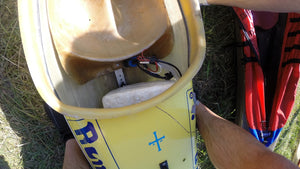
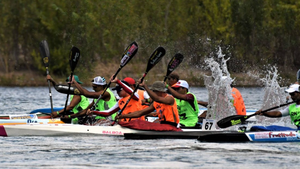
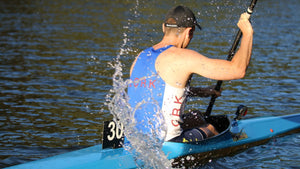
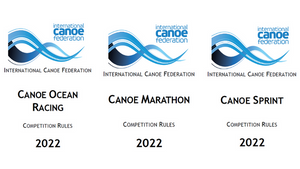
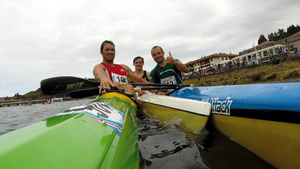
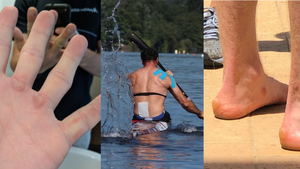
Comments 2
Dave Walker
Feedback on Rev Lovejoy’s answer.
Windsurfers are “planning” vessels, racing kayaks are displacement hulls. Concave shapes have been commonplace on planning hulls for as long as there has been enough power to get a boat “above” the water. If you could paddle hard enough to get a K1 to plane, and keep it there, then other than a completely convex hull might be worth considering, but otherwise, the most perfect convex displacement hull that creates laminar flow along the hull for the greatest distance towards the stern will be the fastest possible design.
The only way I’ve seen a K1 levitate is one that was modified with foils, but of course, that’s illegal….
Riv Lovejoy
Mechanical doping is difficult in Kayaks because they are so simple and open.
However rule changes could be made to improve performance. This would lead to a cost crisis but might be fun to ponder….
1) In the sailing world, underwater geometry is varied depending on speed, direction and intention.
It is very noticeable that much time and speed is lost at starts due to fishtailing. This could be reduced by variable geometry appendages. Same happens at turns, again you could alter the geometry of the kayak to facilitate turning and then return it to straight line mode.
Next the concave issue. If you allow them this allows for greater experimentation. Concaves have been used by Windsurfers for many years.